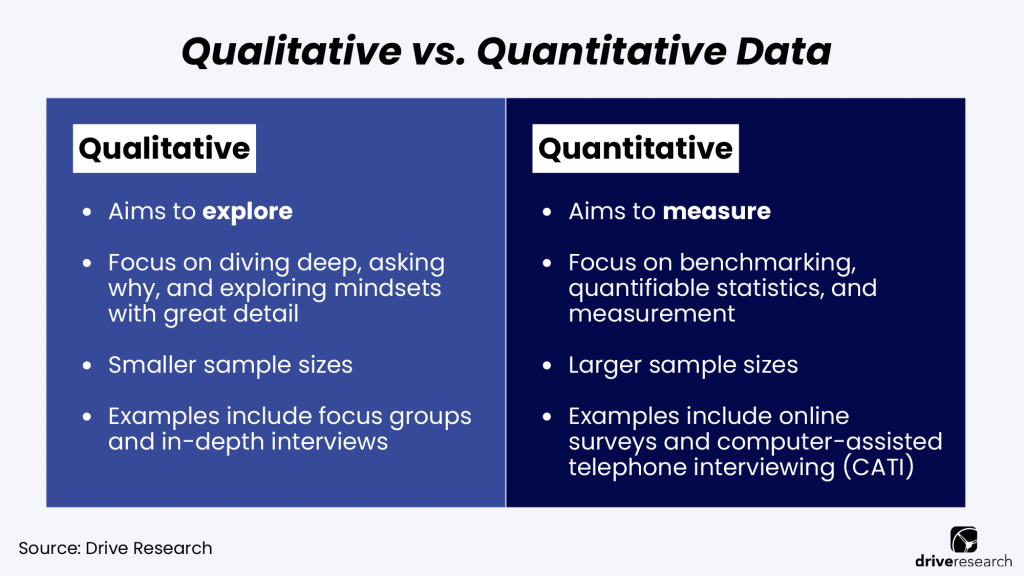
EdTech (Educational Technology) has become a booming industry, offering innovative solutions to enhance the educational experience. It revolutionized the way the educational system learns and teaches.
However, for EdTech companies to succeed, it is crucial to conduct comprehensive market research.
In this blog post, we will explore 6 essential EdTech market research options.
Any of these methodologies will allow your team to gather valuable insights, refine your product or service offering, and maximize your chances of success in the dynamic landscape of educational technology.
Looking to conduct market research for your EdTech company. Contact our education market research company today. Simply fill out an online form for more information.
Why Should EdTech Companies Conduct Market Research?
For EdTech companies, conducting market research is crucial for making informed business decisions. By investing time and effort into market research, you can increase the chances of success for your EdTech venture.
Below we outline the key reasons and benefits of conducting EdTech market research:
1. Determining the latest consumer trends
The education technology industry has a massive customer and user base. It is growing every year.
With a new generation of students and teachers, it is important to always stay up-to-date on the latest trends and the evolving preferences of consumers.
2. Understanding the likes and dislikes of customers
Determining what students and teachers like and what they don’t like about your product are extremely important – especially in these early stages and likely future surge of virtual learning.
3. Understand the differences between purchase decision-makers and users
While school administrators are often the ones making the purchasing decisions for EdTech, students, and teachers often use these products the most.
For instance, through UX market research, our team is able to speak directly to those who use your EdTech product(s) to determine touchpoints that have the most impact on their ability to comprehend the material.
4. Make data-driven decisions
Rather than going with your gut, use market research to help inform the next steps with your EdTech business strategy. Consider different aspects of your product offerings, customer experience, market awareness, and more.
5. Better understand the customer journey
It can be really helpful to understand the journey customers take from when they first start researching new EdTech solutions, to going through the purchase process, and measuring satisfaction with solutions after using the product/service.
How to Conduct Market Research for EdTech
Being that there are many types of EdTech market research options, the market research process varies.
Although, despite the methodology, the study will involve gathering information and insights about target markets, competitors, customer needs, and trends in the industry.
When conducting market research for EdTech, here are the general steps to follow:
- Determine your target audience
- Define your research objectives
- Identify and conduct the EdTech market research
- Analyze the findings
- Take action with the results
- Make a plan for ongoing research
Let’s dive into each of these steps in more detail.
Step 1. Identify your target audience
Determine the specific group or groups of people you want to target with your EdTech product or service. This could be students, teachers, parents, administrators, or a combination of these.
Also, go a level deeper and define the demographics, characteristics, and behaviors of your target audience to guide your research efforts.
For instance, what grade level of students are you trying to reach? What type of education levels do they have?
Though, it’s best not to narrow down your audience targeting too much of the market research will not be feasible.
Step 2. Define your research objectives
Clearly define what you want to achieve through your EdTech market research by identifying the specific questions you want to answer and the areas you need information about.
For example, you might want to understand the demand for online learning platforms in a particular age group or the pricing expectations of potential customers.
Having clear objectives from the start will help to assure you receive the data that is most helpful in driving decision-making.
Step 3. Identify and conduct the EdTech market research
As previously discussed, there are several methods you can use to collect feedback from your target audience.
At a high level, primary market research can be broken into two main categories:
- Quantitative: This typically means developing online surveys to collect measurable data on customer preferences, needs, and behaviors. You can distribute surveys through email, social media, or targeted websites.
- Qualitative: This typically includes conducting one-on-one interviews or focus groups with your target audience. This allows for more in-depth insights and exploratory data because you can ask more open-ended questions to uncover motivations, pain points, and preferences.
There is also the option to use secondary research which involves gathering existing information and data about the EdTech industry. This can include industry reports, market studies, academic research, and articles.
Our EdTech market research company dives into this topic in more detail in our blog post, Difference Between Qualitative and Quantitative Market Research.

Step 4. Analyze the findings
Once you have gathered the primary research data, analyze and interpret it to derive meaningful insights.
Here are a few best practices for analyzing market research findings:
- Before diving into the analysis, revisit the research objectives you defined at the beginning of the project
- Ensure that your data is clean, accurate, and organized before starting the analysis
- Look for patterns, trends, and common themes
- Identify the needs, preferences, and pain points of your target audience
- Utilize visual aids such as charts, graphs, and infographics to present your findings
Then, use this information to refine your product or service offering.
Step 5. Take action with the results
Based on your market research findings, make informed decisions about your EdTech product or service.
Determine how to position your offering in the market, refine your marketing strategy, identify pricing structures, and prioritize feature development.
Step 6. Make a plan for ongoing research
Market research is an ongoing process, rather than a one-and-done study. It is important to continuously monitor the market, track changes in trends, and stay updated on your competitors.
This starts by regularly collecting feedback from customers to ensure your EdTech offering remains relevant and meets their evolving needs.
EdTech Market Research Options
Investing time and effort in market research is an investment in the future of your EdTech business.
Therefore, it’s critical to select the best market research options based on your goals, budget, timeline, and other critical factors.
The most popular EdTech market research options include:
- Online surveys
- Online focus groups
- In-depth interviews
- Mobile ethnography
- Concept testing
- User experience research
Keep reading as we explore each methodology below.
1. Online surveys
If your education technology company is looking to measure or understand a specific objective – online surveys are a fast, quality, and cost-effective option.
This type of quantitative market research is a great methodology to understand educator and student experiences and get the answers to the specific questions you may have.
Working with a third-party EdTech research firm can also suggest questions to include in a survey based on their experience from successful past projects.
Additionally, our market research company can reach any audience through a number of sample pools including proprietary customer email lists, purchased lists, panel vendors, mobile alerts, or targeted social media advertisements.
This assures your online survey is being answered by quality respondents, which will make their feedback that much more reliable to drive data-driven decisions.
2. Online focus groups
For digital products, such as EdTech solutions, conducting online focus groups can easily be conducted through the lens of user experience (UX).
In a group setting that is similar to the now-familiar Zoom classroom, your product users can collaboratively share their opinions.
Plus, online focus groups remove any physical or geographical limitations and are extremely cost-efficient.
In other words, your team is not limited to recruiting participants that live in close proximity to a focus group facility.
Web focus groups or interviews allow a recruitment team to find students, teachers, parents, or whoever matches your target audience from anywhere in the country.
3. In-depth interviews (IDIs)
While a focus group typically consists of four to 12 participants, an in-depth interview dedicates an entire session to the feedback of a single participant.
During an in-depth interview, the interviewer is able to probe and spend more time focusing on smaller details that might need to be skipped over in a group setting, such as a focus group.
Just like a traditional focus group can be conducted online, an in-depth interview can utilize remote methodologies too. Interviews can happen over the phone, in an online chat room, or in a Zoom meeting.
Again, this can significantly open up your sample of participants, which will likely decrease recruitment costs.
4. Mobile ethnography
Collect opinions in a deeper context from students and educators in real-time through their personal devices.
With mobile ethnography, research participants are able to share their honest and candid feedback about your EdTech solution without leaving their (virtual) classroom.
Mobile ethnography participants can share their feedback in a variety of ways including:
- Videos
- Photos
- Audio
- Weekly or daily polls
5. Concept testing
Haven’t launched your EdTech product yet? Thinking of making changes to your existing EdTech solution? No worries, you’ve come to the right place.
This style of education market research allows students and teachers to share their experiences, whether they be positive or negative. By identifying pain points, EdTech companies are able to work out the bugs before the product is introduced to the masses.
Concept testing can help your education technology company introduce your new product idea to the market through a combination of quantitative and qualitative research methods such as online focus groups and in-depth interviews.
6. User experience market research
User experience research can encompass several different research methods such as online surveys, interviews, and focus groups.
Ultimately the type of study depends on the goals and objectives of the research.
Oftentimes, user experience research may include an initial survey of customers about their experience and satisfaction with the product or service.
After the survey is completed, the team may use qualitative research to help supplement the findings from the online survey. This may include interviews or focus groups to learn more about real-life user experience with the EdTech product/service.
Recommended Reading: How to Conduct User Experience (UX) Surveys [+Example Questions]
Final Thoughts
Ed Tech market research is a critical step for any organization looking to succeed in the ever-evolving landscape of educational technology.
In this blog post, we explored six essential market research options for EdTech companies to consider. From conducting surveys and interviews to user experience and observing user behaviors, each option offers unique benefits and insights.
Remember, market research is not a one-time endeavor but an ongoing process. As the EdTech industry continues to evolve, it is crucial to regularly monitor the market, keep an eye on emerging trends, and stay connected with your target audience.
By staying attuned to the changing needs and preferences of your customers, you can adapt your offerings and maintain a competitive edge.
Contact Our EdTech Market Research Company
Drive Research is a full-service market research company. Our team of experts has worked with EdTech companies from across the country to provide both quantitative and qualitative research studies.
Interested in learning how our education technology research firm can help? Reach out today!



